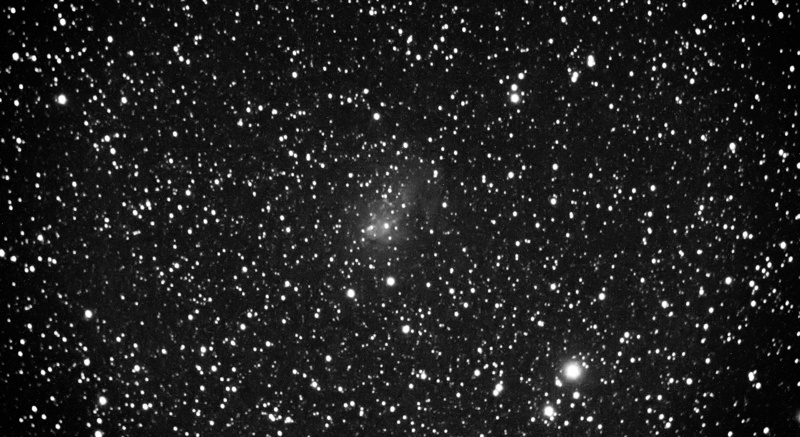Weather Updates;
DSLR imaging: More Cassiopeia DSOs, Star HD7924
Posted: 2 October 2016
Did not open the observatory on Sunday, 25 September 2016, as I supported a star party at Oracle State Park, our local IDA "International Dark Sky Park". I have posted a report.
Monday, 26 September, was cloudy with some rain (0.07"). Had a brief thunderstorm Tuesday morning, 27 September, with 0.15" rain. There was a nice double rainbow in the western sky:

Click or tap on image for larger version
Cloudy skies continued on Wednesday, 28 September, due to a cutoff low pressure system nearby. Remnant moisture from Pacific storm Roslyn brought a strong thunderstorm in the late afternoon with 0.4" rain in about 30 minutes. As the storm was ending one of my webcams captured this lightning:

Thursday, 29 September, was also cloudy, with rain showers in the area. I was at Oracle State Park for a little while in the afternoon and took this iPhone panorama photo of the view across the San Pedro River Valley showing the Galiuro Mountains and a small rainshower:

Click or tap on image for larger version
Shortly after sunset on Thursday a brief strong thunderstorm came through. Dropped 0.18" rain in about 30 minutes.
Friday, 30 September, the final day of the 2016 Monsoon Season, dawned clear with a forecast of a clear night. However, beginning at 0800 MST, as daytime heating began, clouds began appearing in the southern sky. And by 1500 MST a strong thunderstorm was occurring. It added another 0.49" rain in about 15 minutes. Of course, the night was cloudy.
Saturday, 1 October, dawned mostly clear with another forecast of a clear night. But, as was the case the previous day, daytime heating caused cloud buildups. Fortunately, the sky was mostly clear as sunset approached.
|
Open: Saturday, 1 October 2016, 1743 MST Temperature: 90°F |
Session: 1016 Conditions: Mostly clear |
Equipment Used:
12" f/8 LX600 w/StarLock
Wireless AutoStar II handset
2" 24mm UWA eyepiece
2" 50mm eyepiece
Camera:
D7200 DSLR
SYNCed observatory clock to WWV time signals.
1809 MST: sunset.
1812 MST: LX600 ON, StarLock OFF, High Precision OFF.
1816 MST: viewed Venus, 102X. Nice gibbous phase visible.
1820 MST: Mars, 102X. Pretty good view with Syrtis Major visible.
Viewed Saturn, 102X. Cassini Division visible but no moons yet (sky too bright). 1827 MST: the moon Titan was now visible, 102X.
Began preparing the D7200 DSLR for prime focus imaging after the end of Astronomical Twilight.
1835 MST: Saturn's moon Rhea was now visible, 102X. 1836 MST: the moons Dione and Tethys now visible, 102X.
1849 MST: slewed to the star Kaus Borealis (Lambda Sagittarius), which would be the focus star for the first Deep Sky Object (DSO) target. SYNCed the AutoStar II on the star. 1905 MST: mounted the DSLR at prime focus of the 12" LX600 telescope. 1920 MST: did the focus test using the focusing mask. GC Wi-Fi Adapter ON. Used SkySafari 5 Pro on the iPhone 6s Plus to GOTO Terzan 5 (small globular cluster, Magnitude +13). 1924 MST: StarLock ON. Tried some imaging but seeing was not very good and the StarLock autoguiding was having some difficulties. I adjusted the StarLock autoguiding rates, but nothing really helped. Using 25% for both RA and DEC I was able to get this 1 minute, ISO 6400, White Balance 4000K image:

A small faint red nebula is visible but the globular cluster is not.
1950 MST: unmounted the DSLR. StarLock OFF. High Precision ON. Wi-Fi OFF. SYNCed on the star Shedir, then did a GOTO NGC7789 (open cluster in Cassiopeia). Viewed it, 102X. Pretty. Mounted the DSLR at prime focus + focus reducer and focused on Shedir. Took this StarLock autoguided 1 minute, ISO 3200, WB 4000K image of NGC7789:

Then slewed to the star HD7924 (star with 3 "Super Earths" in Cassiopeia. I had imaged it on the previous session but the image was slightly trailed. This is a StarLock autoguided 1 minute, ISO 3200, WB 4000K image, slightly cropped:

I then imaged some galaxies in the constellation of Cassiopeia. All images (slightly cropped) were StarLock autoguided, 5 minutes, ISO 6400, WB 4000K.
NGC147

NGC185

NGC278

IC10

Next were the Heart and Soul Nebula:
IC1805 (Heart Nebula)

IC1848 (Soul Nebula)

I removed the focal reducer for this prime focus image (cropped) of IC1747 (planetary nebula), 30 seconds, ISO 2500, WB 4000K:

2141 MST: ended DSO imaging. StarLock OFF, High Precision OFF.
2153 MST: viewed IC1747 (planetary nebula), 102X. It was small and faint but was a nice view.
Then viewed M31 (Andromeda Galaxy), 102X. Nice view with lots of structure visible. M32 (companion galaxy) was in the same field-of-view. Switched to 49X for a wider view of M31. Also viewed M32 and M110 (companion galaxies).
2208 MST: LX600 OFF.
|
Close: Saturday, 1 October 2016, 2219 MST Temperature: 66°F |
Session Length: 4h 36m Conditions: Clear |
Comments are welcome using Email. Twitter users can use the button below to tweet this report to your followers. Thanks.
Cassiopeia Observatory Home Page
Copyright ©2016 Michael L. Weasner / mweasner@me.com
URL = http://www.weasner.com/co/Reports/2016/10/02/index.html
